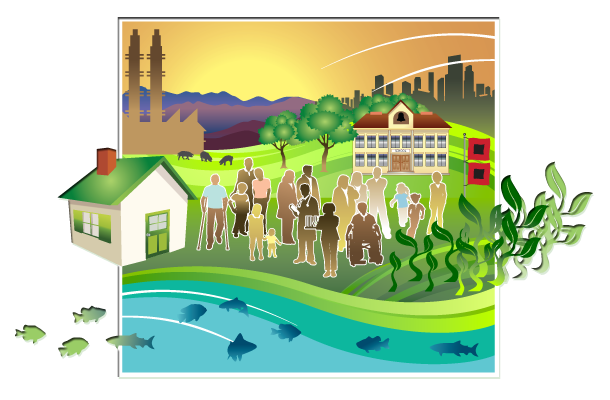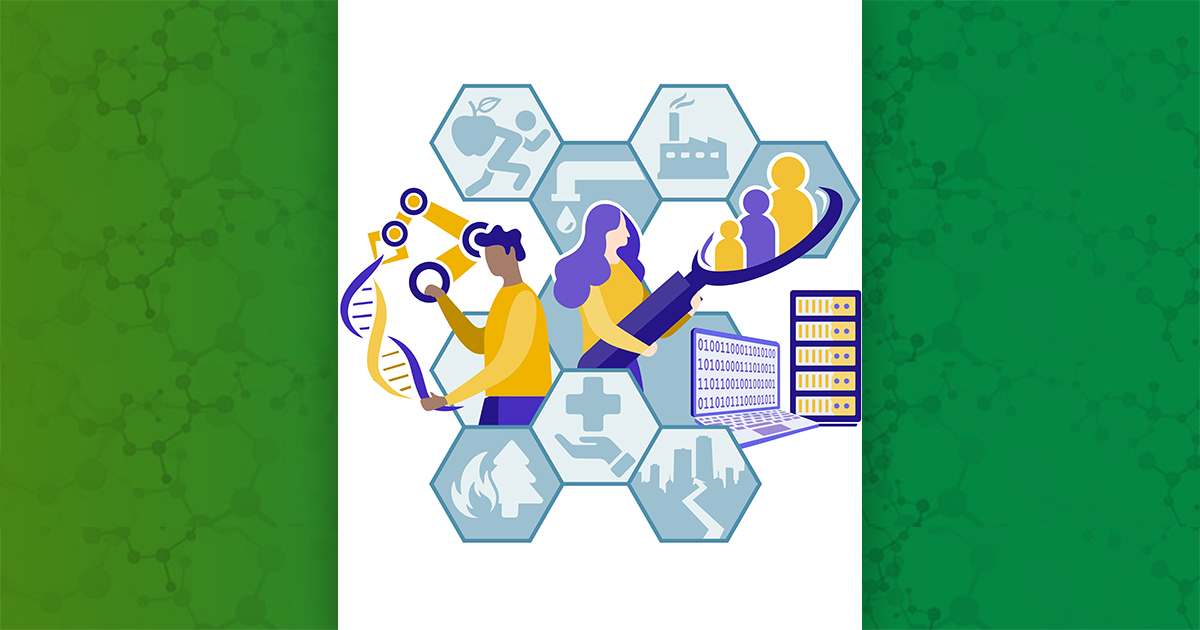App Provides Culturally Tailored Fish Consumption Guidelines to Anishinaabe

“Ojibwe Fisherman” by Roland W. Reed, 1908, demonstrates the cultural history of fishing in the community. (Photo courtesy of Matthew Dellinger)
A phone app for reducing exposure to harmful contaminants from fish consumption was developed for the Anishinaabe (Ojibwe and associated Great Lakes Tribes). It is called Gigiigoo’inaan, which means “our fish” in the Ojibwe language. Phone apps and online environmental health literacy resources can be effective ways to reach community members with important health information.
The culturally relevant app was designed and developed by researchers at the Medical College of Wisconsin who worked with the Chippewa Ottawa Resource Authority (CORA), the Great Lakes Inter-Tribal Council, and the Inter-Tribal Council of Michigan. The research team also tested whether the app was successful at increasing environmental health literacy about fish consumption. This work is described in a September 2022 paper.
“Fishing and fish consumption are important parts of minobimaadiziiwin — or ‘living in a good way,’” stated Amy Poupart, program director for the Great Lakes Native American Research Center for Health. “Restrictive fish consumption advisories are disruptive to our traditions and lifeways. However, there is ongoing work in the community to reduce environmental contaminants, and environmental health literacy interventions, such as ours, complement these efforts.”
Tailoring Recommendations to the Anishinaabe Community
Community members informed the app’s features and content. For example, Gigiigoo’inaan includes Ojibwe names for fish and incorporates traditional artwork. Previous papers describe the app’s development and design, focus group results that informed development, and methods to determine recommended fish consumption.
The app is intended to increase environmental health literacy by including information on recommended consumption amounts of different types of fish. The recommendations are based on CORA’s sampling data for contaminants found in various types of fish. The app also allows for personalization by the user, such as body weight and sex, which allows the user to calculate the maximum fish consumption that is within regulatory limits of contaminants set by government agencies. Additionally, the app shows whether a fish provides healthy fatty acids and how many times the fish may be consumed per week based on the risk of contaminant exposure.
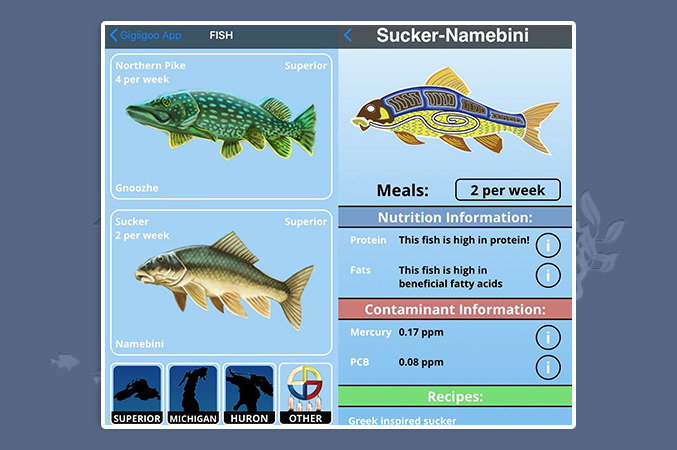
A screen shot of the Gigiioo’inaan app shows an example of the nutrition recommendations and contaminant information for a fish, as well as the corresponding images and artwork. (Photo courtesy of Matthew Dellinger)
“Our team developed this app over several years, incorporating community engaged, culturally appropriate data that truly makes this app unique to the Anishinaabe,” stated Matthew Dellinger, Ph.D., lead investigator of the NIEHS-funded study and co-investigator at the Great Lakes Native American Research Center for Health. “An important part of environmental health literacy is access to information, so the app format, which can be accessed on a smartphone or online on another device, is easily accessible to most people. But providing information tailored to the community is also critical. The Gigiigoo’inaan app meets this goal.”
Fish Consumption App Tested in the Community
The Inter-Tribal Council of Michigan recruited Tribal members to participate in the study through inter-Tribal consortia agreements. The researchers used an experimental study design in which 130 participants had access to Gigiigoo’inaan after researchers determined typical fish consumption before using the app. An additional 136 participants in a control group did not use the app. All participants received compensation for their participation.
The study took place over eight weeks during the Great Lakes winter ice fishing season, when residents typically consume a lot of fish. Throughout this time, researchers sent weekly surveys to participants prompting them to self-report the amount of each type of fish they consumed. Using CORA’s sampling data on contaminant levels in fish, researchers estimated contaminant consumption based on the self-reported data. Researchers also estimated omega-3 fatty acid consumption.
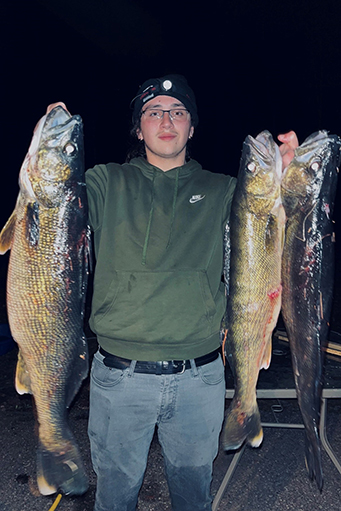
Amy Poupart’s son, Tristain Poupart, and his spring 2022 spearfishing harvest of three large walleye. (Photo courtesy of Amy Poupart)
Interestingly, researchers did not find statistically significant differences between the contaminants consumed by participants using the app and those who did not use the app. Few participants in both the control and app arms of the study exceeded regulatory limits, but encouragingly, the researchers found that most participants were consuming recommended intakes of omega-3 fatty acids, indicating that minobimaadiziiwin and traditional fishing practices promote healthy eating habits. Additionally, app users found Gigiigoo’inaan to be engaging, useful, and culturally appropriate.
“While we did not see large differences in contaminant exposure or fish consumption between the app users and those that did not use the app, we don’t find these results discouraging,” reflected Dellinger. “Quite the opposite. These results show that Anishinaabe community engagement efforts may be encouraging healthy fish consumption behaviors by getting the word out about fish advisories while promoting minobimaadiziiwin, which in turn encourages more fishing and hunting. The main effect we found was a self-reported increase in confidence that fish could be safely consumed by favoring lower contaminant species and limiting others.”
Dellinger provided the example of walleye, a fish species important to the community. Previous advice has flagged large walleye as dangerously high in contaminants, but Gigiigoo’inaan provides a personalized recommendation that increases confidence in safe consumption of that fish without exceeding advisory limits.
In the future, the researchers will look to expand their understanding of how cultural concepts of health and wellness interact with environmental health literacy to promote healthy, exposure-reducing, behaviors. The study is currently in its final phase to assess long-term app use and sustained improvement in environmental health literacy.
Improving Risk Communication by Including Solutions and Safety Information
NIEHS-funded researchers partnered with the Tucson, Arizona water department to improve risk and safety communication around water quality after learning that residents’ concerns over contaminated water had not been fully addressed. The team published their insights from the five-year collaboration in April, detailing how they developed a risk and safety communication model through focus groups with community members, pilot tests, and the development of a risk and safety communications model around messages that meet audience needs. The model is based on the idea that people need information on solutions and actions to keep them safe rather than only details of the relevant public health problem. The model also emphasizes a need to know the audience’s perceived risk and their level of understanding to communicate effectively. The team also developed an online training module to teach public health and water utility professionals how to use the model. The training includes information on how to identify target audiences and a step-by-step process on how to tailor messages to them.
Journal Issue on Environmental Health Literacy and Equity Aims to Decrease Barriers to Information Accessibility
The International Journal of Environmental Research and Public Health published a special issue on environmental health literacy and equity, meant to address barriers that inhibit an individual’s and community’s risk perception, decision making, and health-promoting actions. Papers cover topics such as data trustworthiness, willingness to engage in protective behaviors against health threats, and raising ecological awareness in primary school children.
With the special issue, the editors hope to bring attention to the fact that while environmental health research findings may be available to the public, availability does not equate to accessibility. Additionally, the editors emphasize that low health literacy is more likely to be found among certain groups, such as people who live in under-resourced neighborhoods or are members of minority populations, compared to people who live in affluent areas or are members of the majority population. These inequities, paired with other social and environmental disparities and the fact that health materials are usually written at levels too complex for an average high-school graduate to understand, contribute to the problems of limited health literacy and information accessibility. With this special issue, the editors hope to raise awareness around issues of engagement, information access, and effective approaches to increase health literacy.
NIH Efforts to Build Relationships With American Indian and Alaska Native Populations
NIH endeavors to build meaningful relationships with American Indian and Alaska Native (AI/AN) communities. In July, David Wilson, Ph.D., director of the NIH Tribal Health Research Office, wrote about how to effectively communicate about Tribal health research.
He describes the importance of understanding how the U.S. historically enacted policies to dispossess Tribes of their homelands; the complexities of the relationship between AI/AN and the U.S. federal government; and Tribal values, which, for example, hold health as a holistic construct encompassing several aspects of well-being. Wilson states Tribes are increasingly determining what research is performed within their jurisdictions, as well as playing more active roles in planning, conducting, and interpreting the research.
Communicating respectfully with or about AI/AN people is crucial for effective relationships, and NIH communication tips include:
The Tribal Health Research Office had a role in the NIH adoption of a Tribal Consultation Policy, detailing what Tribal Consultation is and the history of the policy’s development. The policy requires NIH to engage in a formal process of Tribal Consultation before engaging in actions, such as setting research priorities, policies, or programs, that would significantly affect Tribal Nations. Additionally, the National Institute of General Medical Sciences; other NIH Institutes, Centers, and Offices; and the Indian Health Services support the Native American Research Centers for Health, which funds research to meet health needs prioritized by AI/AN Tribes or Tribal organizations.
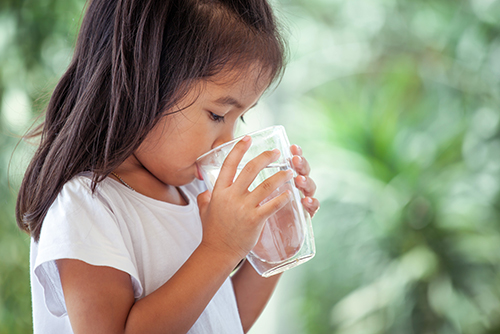
PEPH Environmental Health Chat Podcast Series
Per- and Poly-fluoroalkyl Substances and Your Health
PEPH Environmental Health Chat Podcast Series
Per- and Poly-fluoroalkyl Substances and Your Health
Laurel Schaider, Ph.D., discusses her NIEHS-funded Per- and Poly-fluoroalkyl Substances (PFAS) Research, Education, and Action for Community Health study. The study’s researcher-community partnership focuses on understanding how PFAS affects children’s immune systems. In the podcast, Schaider also talks about the PFAS Exchange, an online resource from the Silent Spring Institute about PFAS in drinking water that can help communities take action to protect their health.

PEPH Grantee Highlight
Andrij Holian, Ph.D.
Andrij Holian, Ph.D., a Ukrainian American, traces his interest in science back to his curiosity that began in childhood. After receiving his Ph.D., his early career experiences sparked an interest in understanding lung injury. Later, as director of research at the Mickey Leland National Urban Air Toxics Research Center, Holian connected his interests in lung disease, exposure assessment, and training new scientists by starting an NIEHS-funded toxicology training program. In 2000, he established the Center for Environmental Health Sciences at the University of Montana in response to concerns about community exposure to toxic asbestos compounds from mining operations. His research now focuses on silica’s health effects on the lung. Holian also mentors college students and develops educational materials for elementary and middle school students.
Funding Opportunites
Notice of Special Interest (NOSI): Climate Change and Health
Encourages applications that address the impact of climate change on health and well-being over the life course, including the health implications of climate change in the United States and globally. NIEHS is leading the NIH-wide Climate Change and Health Initiative, of which this NOSI is a part. NIEHS is interested in research that addresses the impact of climate change on environmental health and innovative approaches to the development of prevention and intervention strategies to reduce the impacts of climate change on environmental health, particularly in communities most susceptible to these impacts. Researchers who wish to submit applications regarding this NOSI must select from a list of funding opportunity announcements sponsored by various NIH institutes and centers. Researchers interested in applying for climate change-related Small Business Innovation Research funding can see Notice of Special Interest (NOSI): Innovative Technologies for Research on Climate Change and Human Health (R43/R44 Small Business Innovation Research (R43/R44 Clinical Trial Optional). Researchers interested in applying for climate change-related Small Business Technology Transfer funding can see Notice of Special Interest (NOSI): Innovative Technologies for Research on Climate Change and Human Health Small Business Technology Transfer (R41/R42 Clinical Trial Optional).
Deadlines: August 8, 2022; October 5, 2022; November 3, 2022
Mechanism for Time-Sensitive Research Opportunities in Environmental Health Sciences (R21 Clinical Trial Not Allowed)
This funding opportunity announcement (FOA) has been extended (NOT-ES-22-013). This FOA is intended to support novel environmental health research in which an unpredictable event or policy change provides a limited window of opportunity to collect human biological samples or environmental exposure data. The primary motivation of the FOA is to understand the consequences of natural and human-made disasters, emerging environmental public health threats, and policy changes in the U.S. and abroad. The distinguishing features of an appropriate study are 1) the unforeseen nature of the event, 2) the clear scientific value and feasibility of the study and 3) the need for rapid review and funding, substantially shorter than the typical NIH grant review/award cycle, for the scientific question to be approached and for the research design to be implemented. It should be clear that the event offers a limited opportunity to address unique and important research questions that could only be answered if the project is initiated with minimum delay. Investigators should describe their capacity to begin the project upon award.
Deadlines: November 10, 2022; December 1, 2022; January 3, 2023; February 1, 2023
Open Competition: Environmental influences on Child Health Outcomes (ECHO) Pregnancy Cohort Study Sites. Clinical Trial Not Allowed (UG3/UH3)
Invites applications for new ECHO Cohort Study Sites to extend and expand the capacity of the ECHO Cohort to further investigate the roles of a broad range of early exposures from society to biology, including the preconception period, on ECHO’s five key child health outcome areas—pre-, peri-, and postnatal; upper and lower airways; obesity; neurodevelopment; and positive health—among diverse populations. The objectives of this FOA are to solicit applications to 1) lead collaborative ECHO Cohort science, 2) recruit new pregnant participants from diverse populations, their resulting offspring, and, if available, the conceiving partner, 3) develop and implement the ECHO Cohort Preconception Pilot Study, and 4) implement the ECHO Cohort Data and Biospecimen Collection Protocol using the ECHO Cohort consortium’s central data capture system, e.g., REDCap Central. This FOA runs in parallel with companion FOAs that solicit applications for Cohort Study Sites only for a limited competition of follow-up of existing ECHO Cohort participants (RFA-OD-22-019), for ECHO Cohort Study Sites only for a limited competition of follow-up of existing ECHO Cohort participants AND of recruitment of new pregnant participants, their resulting offspring, and, if available, the conceiving partner (RFA-OD-22-018), for an ECHO Coordinating Center (RFA-OD-22-021), for an ECHO Data Analysis Center (RFA-OD-22-022), for an ECHO Measurement Core (RFA-OD-22-020), and for an ECHO Laboratory Core (RFA-OD-22-016).
Letter of Intent Due Date: October 21, 2022
Deadline: November 21, 2022
Maternal Health Research Centers of Excellence (U54 Clinical Trial Optional)
Invites applications to participate as a Research Center as part of the Maternal Health Research Centers of Excellence initiative. The purpose of this initiative is to generate innovative approaches to address preventable maternal mortality, decrease severe maternal morbidity, and promote maternal health equity in partnership with communities that are most affected (i.e., Blacks/African Americans, American Indians/Alaska Natives, Hispanics/Latinos, Asian Americans, Native Hawaiians and other Pacific Islanders, sexual and gender minorities, socioeconomically disadvantaged populations, and underserved rural populations). Persons with disabilities are also a priority population. This initiative will use an integrated multi-level approach encompassing structural, social, and biobehavioral research strategies to address the multiple contributing factors that lead to adverse maternal health outcomes and health disparities. Proposed research can address maternal health in the pre-pregnancy, pregnancy, or postpartum period, provided that the research outcomes directly address severe maternal morbidity and/or maternal mortality and equitable health care. This funding opportunity announcement (FOA) runs in parallel with companion FOAs that seek applications for an Implementation Science Hub/Resource Center (RFA-HD-23-037) and a Data Innovation and Coordinating Hub/Resource Center (RFA-HD-23-036). It is expected that all components of the Centers of Excellence, Research Centers, and Hubs, work collaboratively to design and implement research projects, including data collection and data sharing.
Letter of Intent Due Date: November 2, 2022
Deadline: December 5, 2022
PHS 2022-2 Omnibus Solicitation of the NIH, CDC, and FDA for Small Business Innovation Research Grant Applications (Parent SBIR [R43/R44] Clinical Trial Not Allowed)
Enables U.S. owned-and-operated small businesses to conduct research and development that has a strong potential for commercialization. This award and the associated PHS 2022-2 Omnibus Solicitation of the NIH and CDC for Small Business Innovation Research Grant Applications (Parent SBIR [R43/R44] Clinical Trial Required) provide funds for small businesses to stimulate technological innovation in the private sector and strengthen the role of small business in meeting federal research and development needs. The related Small Business Technology Transfer announcements [PHS 2022-2 Omnibus Solicitation of the NIH for Small Business Technology Transfer Grant Applications (Parent STTR [R41/R42] Clinical Trial Not Allowed) and PHS 2022-2 Omnibus Solicitation of the NIH for Small Business Technology Transfer Grant Applications (Parent STTR [R41/R42] Clinical Trial Required)] aim to foster technology transfer through cooperative research and development between small businesses and research institutions.
Deadlines: January 5, 2023; April 5, 2023
Community Partnerships to Advance Science for Society (ComPASS) Program
There are two funding announcements under the ComPASS program: 1) Community-led, Health Equity Structural Intervention Initiative (OT2); and 2) ) Notice of Intent to Publish a Funding Opportunity Announcement for ComPASS Coordination Center (U24 – Clinical Trial Optional). The ComPASS program aims to accelerate the science of health disparities and advance health equity research.
The Community-led, Health Equity Structural Intervention Initiative (OT2) invites applications from community organizations to work in collaboration with their research partners to develop, implement, assess, disseminate, and sustain a community-led health equity structural intervention. The intervention initiative has three phases. It starts with a two-year phase (Phase I) for planning, development, piloting (as appropriate), and building partnerships. It will be followed by a six-year intervention implementation phase (Phase II) and will conclude with a two-year phase (Phase III) for assessment, dissemination, and sustainability efforts. Receipt of an award for Phase I does not guarantee a recipient’s continuation to Phase II or Phase III of the ComPASS Program.
Office Hours: November 8, 2022. The ComPASS program team is hosting Zoom-based office hours for anyone planning to submit a Letter of Intent. Pre-registration is required. Attendees can submit questions prior to the session on the registration form or by emailing [email protected].
Full Application: The ComPASS team will review the letters of intent and invite select groups to submit a full application.
The ComPASS Coordination Center (CC) will provide administration, coordination, data, and research capacity-building and training support to the ComPASS consortium. The consortium includes both community-led, health equity structural intervention projects that intervene on structural factors that create and perpetuate health inequities and health equity research hubs to provide localized technical assistance to the projects. A single coordination center will be funded as an integral part of the ComPASS Program.
Letter of Intent Due Date: November 18, 2022
Deadline: January 23, 2023
Notice of Special Interest (NOSI): Administrative Supplements for Research on Sex And/Or Gender Influences (Admin Supp Clinical Trial Optional)
Supports research highlighting the impact of sex and/or gender influences in human health and illness. The proposed research must address at least one objective from the five strategic goals of the 2019-2023 Trans-NIH Strategic Plan for Women's Health Research. A broad range of research topics studied at the basic, pre-clinical, translational, and clinical levels that address the role of sex and/or gender in health and disease are encouraged. Studies that explore sex or gender influences or the intersection of sex and gender are also encouraged.
Deadlines: January 26, 2022; January 26, 2023
Notice of Special Interest (NOSI): Research on the Health of Women of Understudied, Underrepresented and Underreported (U3) Populations (Admin Supp Clinical Trial Optional)
Supports projects highlighting common sources of disparities in women and girls’ health with a specific emphasis on those that integrate measures beyond the individual level and consider perspectives from multiple disciplines. A broad range of research topics studied at the preclinical, clinical, behavioral, and translational levels are encouraged. Proposals incorporating multilevel interventions, using community-engaged approaches, and focusing on one or more NIH-designated health disparities populations are also desired.
Deadline: January 31, 2022
Accelerating the Pace of Child Health Research Using Existing Data From the Adolescent Brain Cognitive Development (ABCD) Study (R01-clinical Trial Not Allowed)
Supports activities proposing to conduct analyses of existing ABCD Study data to accelerate the pace of research on child health and development, including: cross-sectional and/or longitudinal analyses; development of new or advanced statistical methods; and/or integration of ABCD data with other existing datasets that share common data elements. NIEHS is interested in applications that will use ABCD data resources to examine the contribution of environmental exposures on brain and development and to identify sensitive time windows of development that may confer individual susceptibility and also to identify protective factors that may mitigate environmental-induced changes. An R21 funding opportunity is also open.
Deadlines: June 5, 2022; October 5, 2022; February 5, 2023
Research to Action: Assessing and Addressing Community Exposures to Environmental Contaminants (R01 Clinical Trial Optional)
Encourages multidisciplinary projects to investigate the potential health risks of environmental exposures of concern to a community and to implement an environmental public health action plan based on research findings. Projects supported under this program are expected to employ community-engaged research methods to not only conduct research but also to seamlessly translate research findings into public health action. Check out the Research to Action Currently Funded Grantees webpage for a sense of the types of projects supported through this FOA.
Deadline: January 21, 2020



